A Study to Evaluate the Effectiveness of Planned Teaching Programme Regarding Knowledge on Care of Old Age Health Problems Among Family Members of Simikeri Village (Tal & Dist) Bagalkot
Gundurao Chilapur1, Chetan S Patali*2 and Suvarna S Pinnapati3
1 Phd Scholar of Rajiv Gandhi University of Health Sciences, India
2 Principal, Dhanush Institute of Nursing Sciences, India
3 Suvarna S Pinnapati. Vice-Principal, Dhanush Institute of Nursing Sciences, India
Submission: June 21, 2018; Published: July 03, 2018
*Corresponding author: Chetan S Patali, Principal, Dhanush Institute of Nursing Sciences, Bagalkot, India, Email: chetan1309@gmail.com
How to cite this article: Gundurao C, Chetan S P, Suvarna S P. A Study to Evaluate the Effectiveness of Planned Teaching Programme Regarding Knowledge on Care of Old Age Health Problems Among Family Members of Simikeri Village (Tal & Dist) Bagalkot. JOJ Nurse Health Care. 2018; 8(3):555739. DOI: 10.19080/JOJNHC.2018.08.555739
Abstract
Background of the study: Ageing is a universal phenomenon old age is not in itself a disease, but is a normal part of the human life span. Ageing is normal, universal, progressive, irreversible process. It is an inevitable physiological phenomenon. The human life span follows a recognized pattern birth to death. Then there is a gradual deterioration in physical and mental abilities. As the ageing process progress mental capabilities such as memory and physical abilities further deteriorate. As the individual develops and matures socially and physically from birth through adolescence and after the age of 30years additional changes occur that reflects normal decline in all organ systems, then it is called senescence. This happens gradually throughout the body system reducing the viability of different body systems and increasing their vulnerability to disease.
Objectives
a. To assess the knowledge regarding old age health problems among the family members.
b. To evaluate the effectiveness of planned teaching programme regarding old age health problems among the family members.
c. To find out the association between pretest knowledge regarding old age health problems with selected socio demographic variables
Conceptual Frame Work: For the present study the conceptual frame work is used based on General systems theory by Ludwig Von Bertanlanffy.
Method: This was quasi experimental study with 80 subjects were selected through simple random sampling technique. One group pre test post test design was used. Data was collected by means of structured interview schedule which was divided in to 2 sections (socio-demographic data and knowledge regarding care of selected old age health problems among family members). The reliability of the tool was established by Split Half method. The Karl Pearson’s coefficient of correlation r = 0.7999 Planned teaching programme on care of selected old age health problems was developed. After content validity of the tool was established by six experts. Data was analyzed by using descriptive and inferential statistical in terms of frequency, percentage, mean, standard deviation, student‘t’ test values.
Results: It was proved that there was increase in the knowledge level of family members after implementing planned teaching programme, thus planned teaching programme on care of selected old age health problems among family members was effective. Out of 80 subjects 42 (52.50%) of subjects had inadequate, 31 (38.75%) had satisfactory and 7 (8.75%) had adequate knowledge regarding care of selected old age health problems before teaching programme (pre test). However after teaching programme (post test) about 21(26.25%) subjects had adequate knowledge and 37(46.25%) satisfactory knowledge, where as 22(27.50%) had inadequate knowledge regarding care of selected old age health problems.
Conclusions: The study proved that planned teaching programme on care of selected old age health problems among family members was scientific, logical and cost effective strategy.
Keywords: Family members; Care of selected old age health problems; Planned teaching programme
Introduction
You must be humble enough to love, so that you will touch the hearts of others and make them think of you with love. It is better to be forgotten entirely than to be remembered without love [1]. According to the United Nations the word old age is defined an age person as one who is 60years and above. Generally people above age of 60years are considered as senior citizens. Indian people between 60-75years are categorized as “young old” between 75-85years as “old-old” and people above the age of 85years are classified as “very old” or inferno. There is marked difference in the health needs of these age groups [46]. Ageing is a universal phenomenon old age is not in itself a disease, but is a normal part of the human life span. Ageing is normal, universal, progressive, irreversible process. It is an inevitable physiological phenomenon. The human life span follows a recognized pattern birth to death. Then there is a gradual deteriorisation in physical and mental abilities. As the ageing process progress mental capabilities such as memory and physical abilities further deteriorate [1]. Most of the care of dependent older people in the community is carried out by families in the home of older person. Old age is certainly accompanied by problems for a significant number of elderly people and care of elderly people is largely concerned with assessing these problems and their compensating for them or participating in the process of helping the elderly person to overcome them and regain a degree of independence. The increasing population of older people has sought the attention of world community. Emphasis is given on healthy and active ageing. It implies being holistically fit, being mobile, coping well with various living activities. It is very important to take care of old people when they are not well [2,3]. Nearly 72% of elderly live in rural and half of these are below poverty line. The remaining 28% of elderly live in urban areas. Further, about 90% of old person in India, are from unorganized sector. Around 10% of elderly belong to organized sector that have access to some distinct benefits like service pensions and health care facilities in the shape of CGHS, etc. The implication of ageing populations is earmark lot of budget to deal with their needs and problems. It is also adds on to dependent population in India [4-6].
Need for the Study
The word “aged” is relative depending upon the society. The term “Graying of Nations.” “Aging of Nations” and demographic transition of “Pyramid to Pillar” are the concerns voiced all over the world. The word “geriatrics” was coined by Naseher in 1914 and, is derived from Greek word gerus & iatrea, which means old age and treatment respectively [7]. Ageing is a universal phenomenon old age is not in itself a disease but is a normal part of the human life span. Ageing is normal universal progressive irreversible process. It is an inevitable physiological phenomenon the human life span follows a recognized pattern from birth to death there is a gradual deterioration in physical and mental capabilities, such as memory and physical abilities further deteriorate [1]. The study conducted on health problem among the aged persons of 60years at rural area of Calcutta. The result reveals that, main health related problems were (45.7%) hypertension, (47.8%) diabetes mellitus, and (54.3%) arthritis [8].
Materials and Methods
Objectives of the Study
a) To assess the knowledge regarding old age health problems among the family members.
b) To evaluate the effectiveness of planned teaching programme regarding old age health problems among the family members.
c) To find out the association between pretest knowledge regarding old age health problems with selected socio demographic variables.
Operational Definitions
A. Evaluation: In this study evaluation refers to the process used to signify differences between pre & post test scores, of family members regarding care of old age person
B. Effectiveness: In this study effectiveness refers to the significant differences in the pre & post test knowledge scores on selected aspect of care of old age health problems among family members
C. Planned Teaching Programme: In this study planned teaching programme refers to a planned health education regarding knowledge on care of selected old age health problems such as hypertension, arthritis, cataract & diabetic mellitus among family members, developed by investigator.
D. Knowledge: In this study knowledge refers to the correct responses given by family members about care of old age health problems.
E. Old Age People: In this study, old age people refer to persons who are aged 60 years & above, of both sex.
F. Selected Health Problems: In this study selected health problems refers to the health problems commonly affecting to the old age people, like Hypertension, Arthritis, Cataract and Diabetes mellitus.
Objectives of the Study
a. The family members of simikeri village have some knowledge regarding care of the old age health problems.
b. There is significant association between pre & post test knowledge score of respondent regarding care of old age health problems among family members.
c. The result of the study will help to take care of the old age health problems by family members.
Hypothesis:
H1: The mean post test knowledge score of family members exposed to planned teaching programme on care of age health problems will be significantly higher than their mean pre test score.
H1: A significant association will be found between the knowledge of family members regarding care of old age health problems with selected socio-demographic variables [9].
Methodology
Population
Population includes all possible elements that could be included in research [10].
The target population of the study is the family members of old age persons of Simikeri village (Tal & Dist) Bagalkot.
The accessible population of the study is the family members of old age persons of Simikeri village (Tal & Dist) Bagalkot.
Sample
Sample is a small portion of the population selected for observation and proper analysis.40 The sample for the present study composed of 80 family members of old age persons of Simikeri village (Tal & Dist) Bagalkot [11].
Sampling Technique
Sampling technique is the procedure, which the researcher adopts in selecting the subjects for the study.1
In view of the objectives of the study simple random sampling was used.
Sampling Criteria
Inclusion Criteria
a. The family members who are willing to participate in study.
b. The family members who are present at the time of data collection.
Exclusion Criteria
a. The family members who are not willing to participate in study.
b. The family members who do not know English or Kannada.
c. The family members who are sick.
Results
A. Age: The following diagram represents the percentage distribution of study subjects by age groups. Out of 80 subjects, 48.75% of the subjects belong to20-29 years, followed by 32.50% in the age group of 30-39 years, and 18.75% in the age of 40years above (Figures 1 & 2).
B. Marital Status: The following diagram represents the percentage distribution of study subjects by marital status. 66.25% were married and 33.75% were un-married (Figure 3).
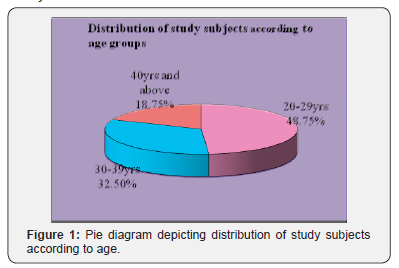
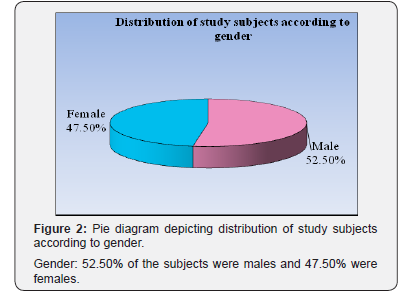
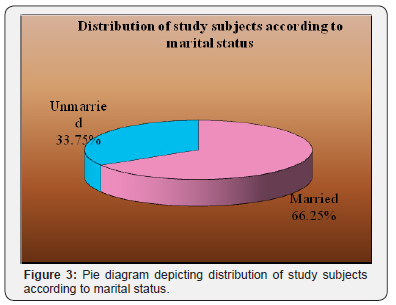
C. Religion: The following diagram represents the percentage distribution of study subjects by religion. Majority 46.25% of the samples were Hindus, 21.25% of the samples were Muslims, 15.00% of the samples were Christians, and 17.50% of the samples were others (Figure 4).
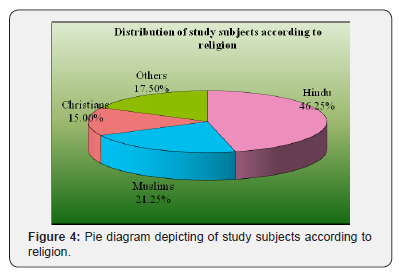
D. Educational Status: The following diagram represents the percentage distribution of study subjects by educational status. Out of 80 subjects, 41.25% subjects had no formal education, 35.00% up to Primary level, 16.25% had Secondary level, and remaining 7.50% had PUC & above level education (Figure 5).
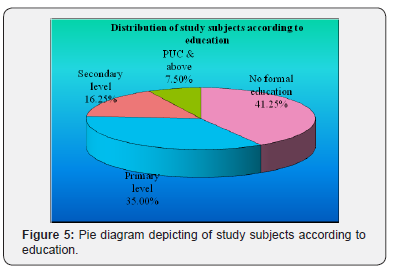
E. Occupation: Majority 47.50% of the samples were agricultures, 18.75% were doing collie, 15.00% were private employees, 10.00% had government job, while 8.75% were with business (Figure 6).
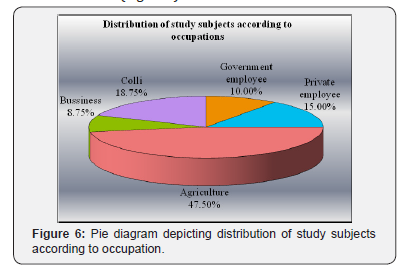
F. Types of Family: 71.25% were belongs to joint families while 28.75% belonged to nuclear family (Figure 7).
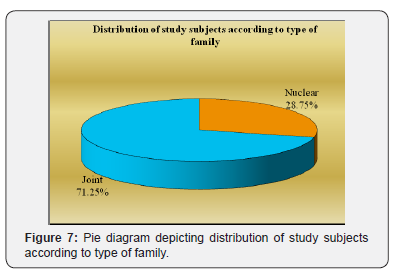
G. Income: 48.75% of the sample had an income between Rs 3000–5000, 26.25% had between Rs7001-9000, 13.75% were of Rs5001-7000 and 11.25% had Rs 9001 & above (Figure 8).
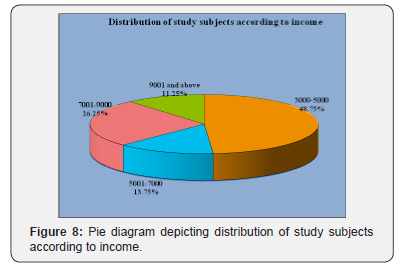
H. Relationship with the old Age Person: The following diagram shows relationship with the old age person 30.00% were son, 26.25% were wife, 23.75% were husband, 15.00% were daughter and 5.00% of others [12,13] (Figure 9).
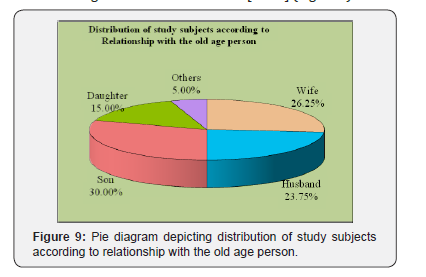
Assessment of Pretest and Post Test Knowledge Level
Level of Knowledge: Table 1 represents that, out of 80 subjects 31(38.75%) had satisfactory knowledge, 42(52.50%) had inadequate and only 7(8.75%) subjects had adequate knowledge before implementation of teaching programme (pre test). However after teaching programme (post test) about 21(26.25%) subjects had adequate knowledge and 37(46.25%) satisfactory knowledge, where as 22(27.50%) had inadequate knowledge. The above findings states that “Research hypothesis H1: There is significant difference in the knowledge of family members regarding care of selected old age health problems before and after administration of planned teaching programme” as stated by the investigator earlier was accepted. The area wise pre test and post test knowledge percentage given in the above Table 2 clearly and the change in percentage is the effectiveness of the planned teaching programme (Figure 10).



From the results of above Table 3, we clearly seen or observed that, the pre test and post test total knowledge scores are found to be statistically significant (t = -7.4832, P = 0.0000). It means that the post test knowledge scores (63.63 ±16.04) is higher than pre test scores (47.84 ±11.95). Similarly the dimension like knowledge about hypertension post test scores are higher (62.15±21.97) as compared to (51.75±18.6) and found to be statistically significant (t = -3.3760, P = 0.0011), the knowledge about diabetic mellitus in the post test scores are higher (63.50±20.63) as compared to (43.50±16.54) and found to be statistically significant (t = -7.0131, P = 0.0000), the knowledge about cataract the post test scores are higher (63.25±19.21) as compared to (47.75±16.99) and found to be statistically significant (t = -6.0429, P = 0.0000) and the knowledge about arthritis the post test scores are higher (65.62±21.63) as compared to (48.37±17.24) and found to be statistically significant (t = -5.5527, P = 0.0000). In other words the post test scores of total knowledge and its dimensions are higher than the pre test scores [14,15].
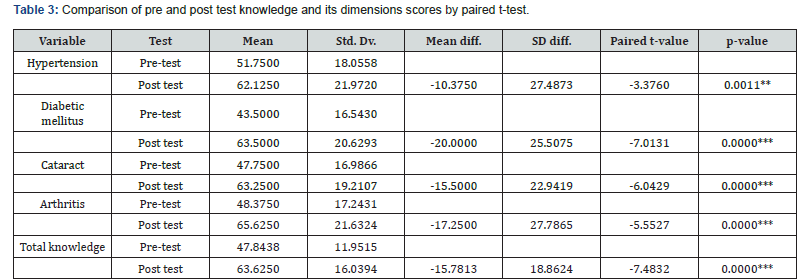
Discussion
a. Majority 48.75% of subjects were between 20-29 years of age, 32.50% were between 30-39 years of age and 18.75% were above 40years of age.
b. Majority 52.50% of the subjects were males and rest 47.50% were females.
c. Majority 66.25% of the subjects were married and remaining 33.75% were unmarried.
d. Majority 46.25% of samples were Hindus, 21.25% were Muslims, 17.50% were others and 15% were Christians [16].
e. Majority 41.25% had no formal education, 35% had primary education, 16.25% had secondary education and 7.50% had PUC and above level of education status.
f. Majority 47.50% were having Agricultures, 18.75% had Collies, 15% were Private employee, 10% had Government employee and 8.75% were Business.
g. Majority 71.25% were Joint family and 28.75% of the subjects were from nuclear family.
h. Majority 48.75% had Rs 3000-5000/month, 26.25% were Rs 7001-9000/month, 13.75% had Rs 5001-7000 PM and 11.25% had Rs 9001 and more income per month.
i. Majority 30% of the subjects were son, of old age person 26.25% were wife, 23.75% were husbands, 15% were daughters and rest 5% were others [17].
The first objective was to assess the existing knowledge regarding old age health problems among the family members. The result of the study clearly indicated that out of 80 subjects 42(52.50%) of subjects had inadequate knowledge, 31(38.75%) subjects had satisfactory and only 7(8.75%) had adequate knowledge regarding care of selected old age health problems before planned teaching programme (pre test). However after planned teaching programme (post test) about 37(46.25%) subjects had satisfactory knowledge, 22(27.50%) had inadequate and 21(26.25%) had adequate knowledge regarding care of selected old age health problems [18-20].
Recommendations
The study can be replicated on larger sample in different villages.
a. A comparative study can be conducted between urban and rural family members regarding care of selected old age health problems.
b. A study can be conducted with to evaluate the effectiveness of video assisted teaching module regarding care of old age health problems among family members.
c. A study can be conducted to assess the knowledge and practice regarding care of old age health problems among health worker working at old age homes.
d. A study can be conducted to assess the knowledge, attitude & practice regarding care of selected old age health problems among family members.
References
- Abdellah FG (1986) Better patient care through Nursing research. Mc Milan publishing Co. New York, USA.
- Alba Aguado, Flora Lopez, Sonia Miravet, Pilar Oriol, M Isabel Fuentes, et al. (2009) Hypertension in the very old; prevalence, awareness, treatment and control: a cross-sectional population-based study in a Spanish municipality. BMC Geriatric 9: 16.
- Alligood MR, Tomey A (2003) Nursing theories; Utilization and application. (2nd edn) St. Louis: Mosby, Nursing Science Quarterly, USA, 16(1): 93-94.
- BT Basavantappa. A text book of “Nursing Research” First edition, Jayapee Brothers Medical Publishers (P) Ltd, B.3 EMCA House, 23/23 B Ansari Road, Daryaganj Post Box 7193 New Delhi 110002. India.
- Bekibele CO, Gureje O (2008) Impact of self reported visual impairment on quality of life in the Ibadan study of aging. Br J Ophthalmol 92(5): 612-615.
- Bhatia S, Swami HM, Thakur JS, Bhatia V (2007) A study of health problems and Loneliness among the elderly in Chandigarh. Indian J Community Med 32(4): 255-258.
- Carnethon MR, Yan L, Greenland P, Garside DB, Dyer AR, et al. (2008) Resting heart rate in middle age and diabetes development in older age. Diabetes Care 31(2): 335-339.
- Carol A Miller (1999) Nursing care of older adults and practice (3rd Edn.), Lippincott Williams Wilkins, 227, East Washington Square, Phidelphia, USA.
- Catherine ward Griffin (2004) Nurses as caregivers of elderly relatives. Canadian Journal of Nursing research 36(1): 92-114.
- Chen YM, Chen LK, Lan JL, Chen DY (2009) Geriatric syndromes in elderly patients with rheumatoid arthritis. Rheumatology(Oxford) 48(10): 1261-1264.
- Chou KL, Chi I (2005) Prevalence of depression among elderly Chinese with diabetes. Int J Geriatr Psychiatry 20(6): 570-575.
- Creasia JL, Parker B (1991) Conceptual foundations of professional practice (1st Edn.), Mosby, USA pp.679.
- Dane FC (1990) Research Methods (1st Edn.), Brooks Kale Publishing Company, California, USA.
- Dey AB, Soneja S, Nagarkar KM, Jhingan HP (2001) Evaluation of the health and functional status of older Indians as a prelude to the development of a health programme. Natl Med J India 14(3): 135-138.
- Frank A Sloan, Daniel W Belsky, Idrissa A Boly (2008) Prevalence of major eye diseases among US Civil war veterans. Arch opthalmol 126(2): 246-250.
- Gotta M, Seymour J, Bellamy G, Clark D, Ahmedzai S (2004) Older people’s views about home as a place of care at the end of life. Palliative Medicine 18(5): 460-467.
- Greenberger H, Litwin H (2003) Can burdened care givers be effective facilitators of elder care- reciepient health care. J Adv Nurs 41(4): 332- 341.
- Gupta HL, Yadav M, Sundarka MK, Talwar V, Saini M, et al. (2002) A study of prevalence of health problems in asymptomatic elderly individuals in Delhi. J Assoc physicians India 50: 792-795.
- H Agarwal, S Baweja, KR Haldiya, A Mathur (2005) Prevelence of hypertension in elderly population of desert region of Rajastan. Journal of the Indian Academy of Geriatrics 1: 14-17.
- WHO (2011) National Institute of Aging. USA, p. 32.






























